Battery Multiple Unit - Derby 2-car BMU
Operations
Before moving north to Aberdeenshire the set made nocturnal trial runs on the Kelvin Valley Line.
The Deeside Line
The Aberdeen-Ballater line was chosen so that an adequate test over a period could be made of battery and car capacity. At 43 miles long the branch had 12 intermediate stations and the two terminals, imposing frequent accelerations from standstill on the battery. There were also ruling gradients of 1 in 70 and others of 1 in 68 which required substantial discharge rates for any appreciable speed to be maintained up them. As built there was no actual indication as to how far the batteries would go between recharging when in service on the Deeside line: but it was not proposed to work them to near the limit, as initial schedules gave the opportunity to recharge, partially at least, in the 50 to 60 minute lie-over times at both terminals. But it was known that the bogie battery cars in Germany, with two 100-kW motors and batteries of 850-940 amp/hr. on the three-hour rate, were expected to run 100 to 150 miles between recharging when hauling a control trailer, and on some rosters they covered 300 miles a day with several partial-recharge periods as lie-over times permit. In these cases lie-over times of three to five hours at night permitted full recharge at off-peak charges.
Though the vehicles had a top designed speed of 60 mph, the line speed was 50 mph.
Press Launch
A formal initial run on the line was made on Wednesday 26th March 1958, with many of the population of the town of Ballater turning up, despite the wintry conditions. A special steam train from Aberdeen brought Sir Ian Bolton, along with the Rt. Hon Thomas Johnston, Chairman, and other members of the North of Scotland Hydro-Electric Board, and Mr James Ness, General Manager of the Scottish Region of British Railways. There was also a large party of civic and county representatives and members of commerce, industry, and the press. The steam special was met at Ballater by the local ATC pipe band, playing appropriate music. The party of 117 travelled on the Battery Railcar for a journey to Aberdeen at 4.21 pm, driven by driver James Kinnaid of Ballater. During the journey, comments on the experiment were made by means of loud speaker equipment, and good wishes for its success were expressed by many of the guests.
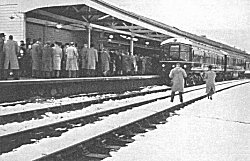
It was a wintry day on the 26/3/58, but this did not deter a large crowd from appearing for the send-off.
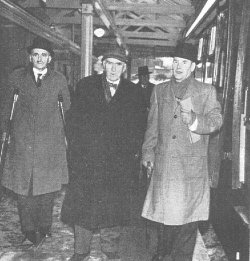
Sir Ian Bolton, Rt. Hon Thomas Johnston and Mr James Ness about to join the BMU at Ballater.
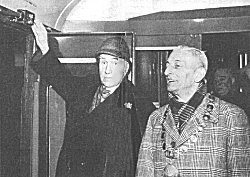
The Rt Hon. Thomas Johnston signals the driver. With him is Provost Begg from Ballater.
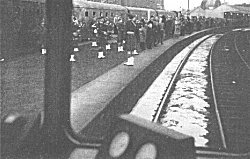
As the set left the Ballater ATC pipe band played appropriate music.
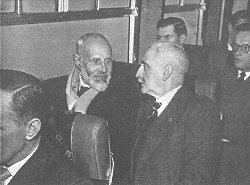
Sir Ian Bolton chats with the Marquis of Aberdeen during the trip.
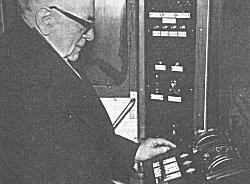
Lord Provost Stephen, Aberdeen, studies the control panel of the railcar.
Services Begin

The vehicles were introduced to regular workings on the Aberdeen - Ballater service several weeks later, to allow for drivers and maintenance staff to be trained. The first day, Monday 21st April, was a Spring holiday and when it left at 9.40am every seat was occupied.
Special tickets were issued for travel on that day, a normal ticket also had to be purchased. Arthur Usher.
A tri-fold brochure was produced for the launch, which contained the timetable from April 21 to June 7th 1958:
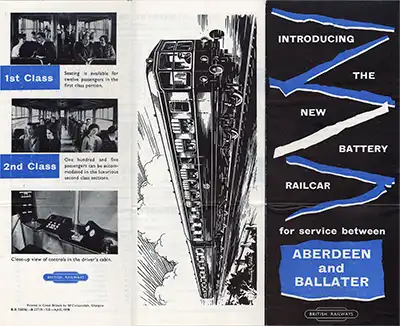
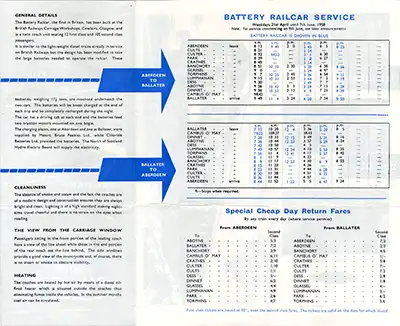
A Met-Camm two-car set (51239 / 56397) was introduced on the opposite diagram from Monday 7th July, eliminating all steam passenger services. The last booked steam diagram was on Saturday 5th July, the 6.15pm Aberdeen - Ballater and 8.25pm Ballater to Aberdeen. The following weekend the BMU was at Inverurie for inspection, and so steam also operated the 8.25pm Aberdeen - Ballater.[1]
Tail traffic could not be carried by the BMU, and the vehicles were prohibited from assisting disabled trains.
After an extremely successful debut of several months continuous running, marred only by a failure at Dinnet on the Aberdeen Autumn Holiday Monday, the unit disappeared of to Inverurie Works at the end of October 1958 until at least mid-November. Replacement twin sets were easily obtainable from Dundee as the local services did not start there as planned and their 101s were mostly spare. Dundee also supplied and maintained one set at Kittybrewster for working the Ballater runs not covered by the Battery set.

'Setright' ticket machines were introduced on the line from 9/3/59, tickets being issued by the guards for all intermediate stations.
The image shows 79998 / 79999 seen at Park station on the 19th May 1959 on a Ballater - Aberdeen service. Hamish Stevenson.
Overnight stabling was at Ballater until 1960 when this was changed to Aberdeen.
The BMU was notable for its smooth and silent running, and it operated at costs very closely approaching that of DMUs. The set up cost of the project was quoted as £50,000. After a few months experiences the true running costs could be assessed. Unfortunately, with two battery charging stations and only one railcar the project was not helped by the poor utilisation of the relatively expensive chargers.
The bi-fold Summer 1960 timetable, scans courtesy of John Paton:
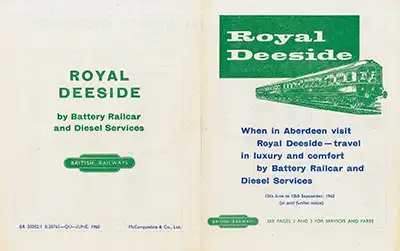
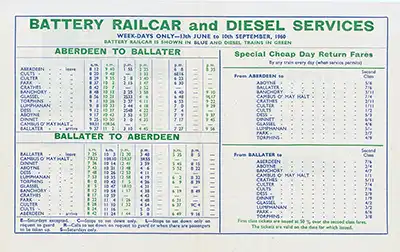
About October 1960, the BMU disappeared from the route for a while, replaced by Class 100/105s (it may have been out of use for about a year).
In early June 1962 the set was re-equipped with a new form of battery that offered several advantages. However a series of breakdowns and minor fires saw he unit being reported as withdrawn in August 1962, and replaced by a second DMU. The set was sent to Hyndland depot in Glasgow for a decision on its future.

The set eventually returned to traffic. The image shows Sc79999 being recharged in Aberdeen station on Sunday 5th July 1964. Michael Mensing. Ducting was fitted to allow cool air from an external source to be circulated around the batteries when charging.
The unit was still specifically mentioned in the 1965 working timetable. The line was to close in 1966. The set was put into store at Cowlairs until claimed by the RTC.
References
- ⋏ August 1960 p250 Railway Observer (Railway Correspondence and Travel Society)
Summary
Background
Description
Numbering & Driving Instructions
Operations
Non-Passenger Use
Images
Details about the unit in preservation can be found here.
The following publications were consulted in the
preparation of this article:
Railway Gazette; 25 Years of Research - C. Marsden; British Railways
Scottish Region Staff Magazine; Scottish Urban & Rural Branch Lines
- G. O’Hara; The Deeside line - Dick Jackson; Railway Observer;
Railway Bylines Summer Special No.1.
All pictures are official ScR images unless otherwise stated.


